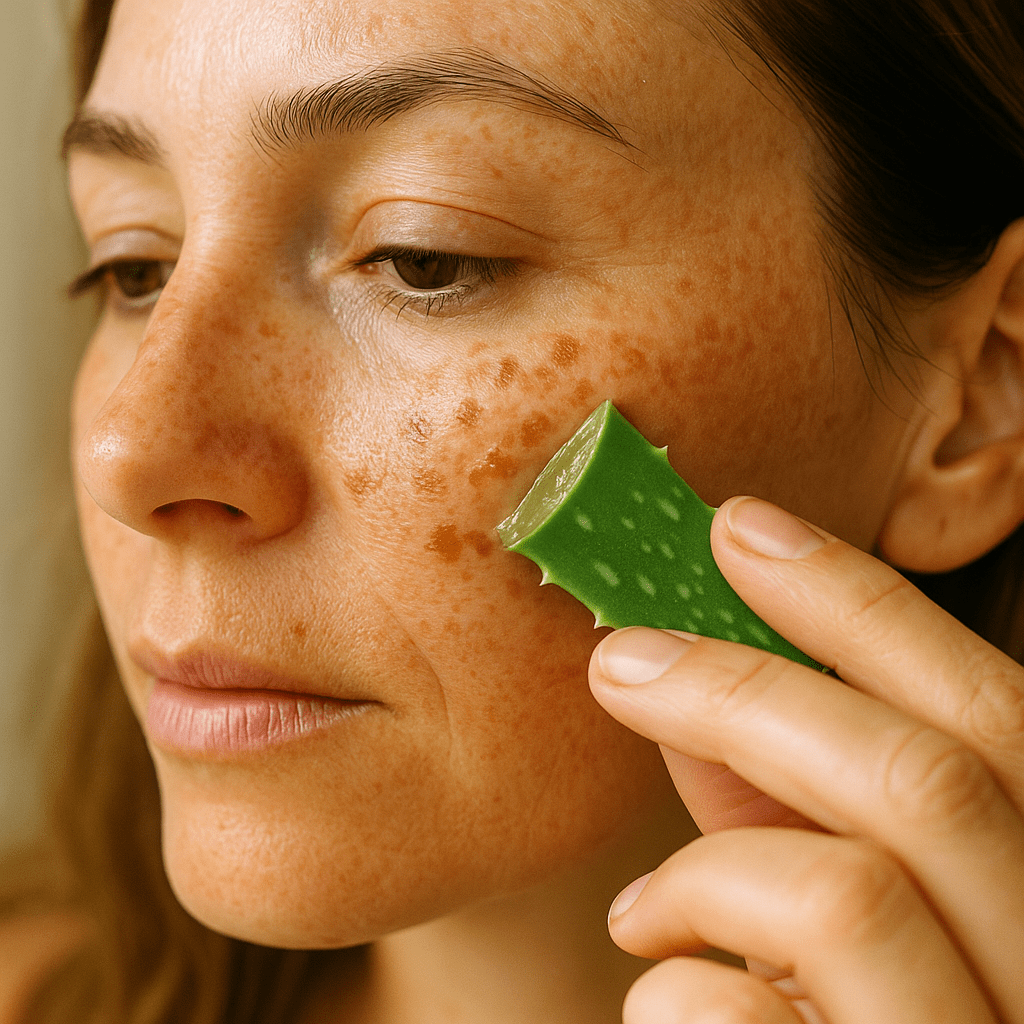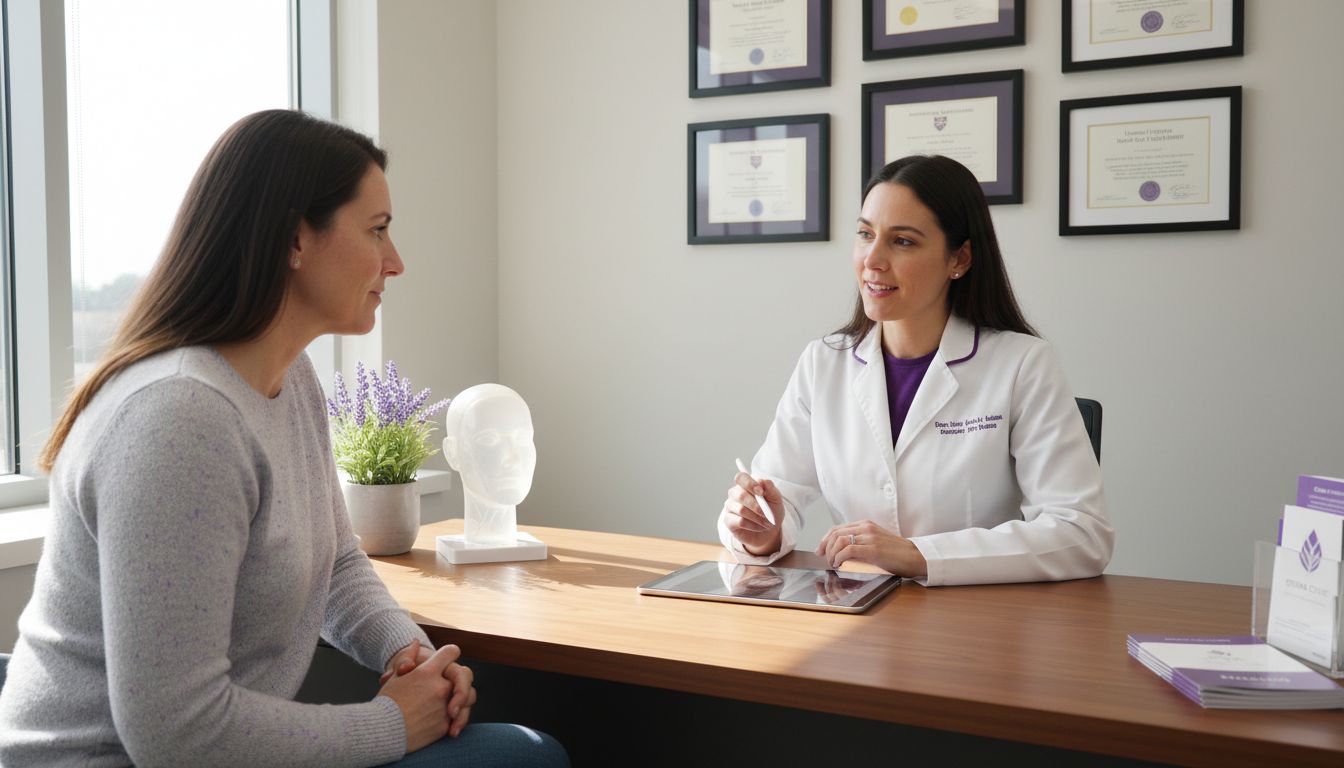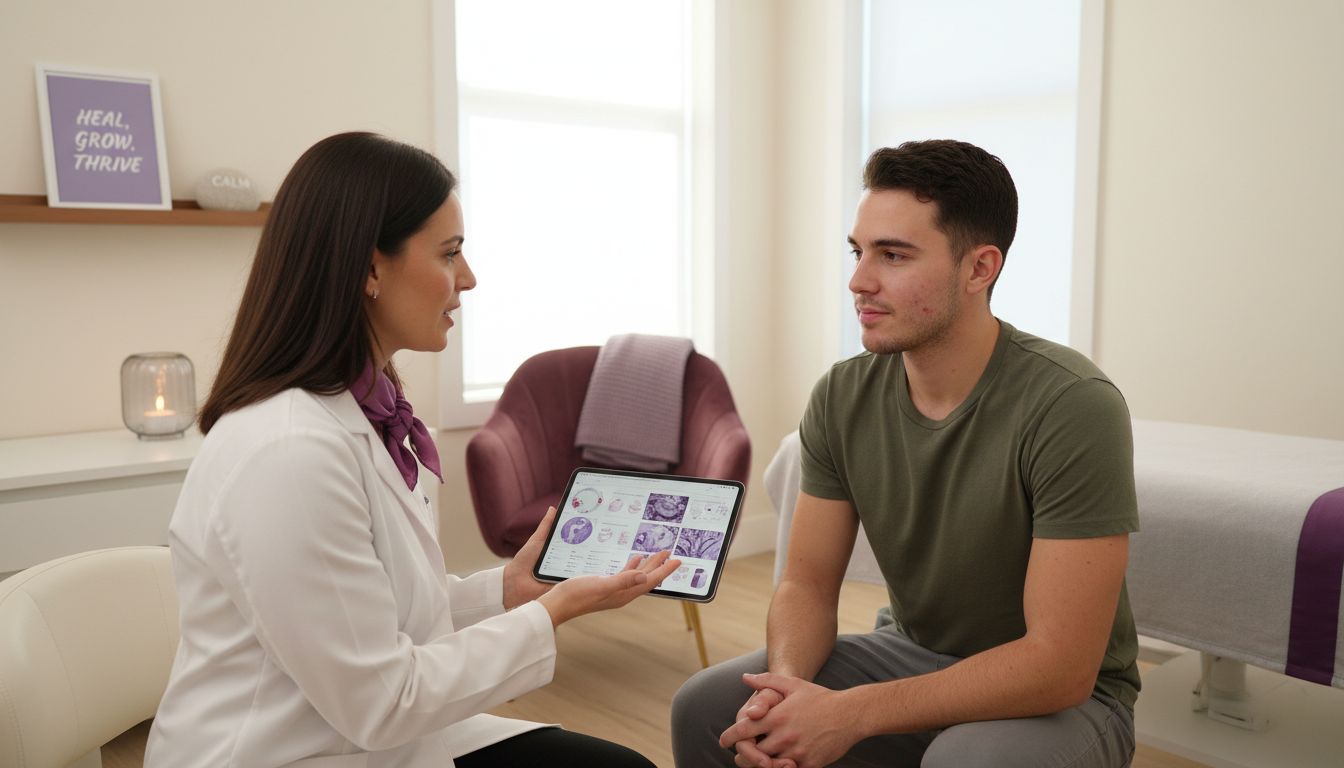Sun spots on the face are a common sign of accumulated sun exposure over the years.
But what are they, exactly?
Here’s a complete cheatsheet on how to get rid of sun spots on face, covering natural remedies and advanced treatments.
Some are stubborn, flat, and tan or brown marks called solar lentigines.
Some are harmless but impact your confidence and complexion.
Some respond well to natural antioxidants like vitamin C and aloe vera.
Some might need professional interventions like chemical peels or laser treatments.
Some can be prevented with simple daily habits such as sunscreen and protective clothing.
Let’s dive right in.
What Are Sun Spots and Why Do They Appear on the Face?
Sun spots, also known as age spots or solar lentigines, are flat, dark patches that appear on skin areas frequently exposed to ultraviolet (UV) radiation. These spots result from an increased production of melanin – the pigment that gives skin its color – caused by prolonged sun exposure over many years. They commonly appear on the face, hands, shoulders, and arms.
Unlike freckles that often fade without sun exposure, sun spots tend to persist and even increase in size and number as we age. While they are generally harmless, sun spots signal that your skin has experienced substantial sun damage, a process medically described as photoaging. Photoaging not only affects skin appearance but also increases risk for more serious skin conditions.
Understanding the mechanisms behind sun spots helps us choose effective methods for how to get rid of sun spots on face, whether naturally or through professional care.
Sun spots aren’t the same as deeper skin cancers, but their visible presence reminds us to be vigilant about skin health and protection.
How Can You Prevent Sun Spots from Forming?
Before exploring treatments, prevention is the best strategy to avoid or minimize sun spots. Here are key preventive measures:
- Daily Sunscreen Use: Applying broad-spectrum SPF 30 or higher sunscreen to all exposed skin every day, even on cloudy days, is critical. Reapply every two hours when outdoors.
- Protective Clothing: Wearing wide-brim hats, UV-blocking sunglasses, and clothing with a UPF rating helps shield skin from harmful rays.
- Avoid Peak Sun Hours: UV radiation is strongest between 10 a.m. and 4 p.m. Limiting sun exposure during these hours reduces damage.
- Seek Shade: Whenever possible, stay under umbrellas or trees to minimize direct UV exposure.
- Avoid Tanning Beds: Artificial UV light is just as harmful and accelerates skin damage.
- Regular Skin Checks: Monitor your skin regularly and consult a dermatologist for suspicious spots or changes.
Remember, even with prevention, existing sun spots can be addressed safely with effective remedies.
What Natural Remedies Help Fade Sun Spots on the Face?
If you’re wondering how to get rid of sun spots on face naturally, many ingredients and habits support fading hyperpigmentation over time. While natural options may take longer to see visible results, they nourish and protect the skin deeply.
Here are some effective natural remedies:
Aloe Vera Gel
Aloe vera’s enzymes promote skin healing and regeneration. Applying fresh aloe vera gel directly to sun spots for 30 minutes daily may reduce pigmentation gradually by helping repair damaged skin cells.
Vitamin C (L-ascorbic Acid)
Topical vitamin C is a potent antioxidant known to brighten skin and promote collagen synthesis. Using serums or creams containing vitamin C can lighten sun spots and improve overall complexion. Consult with skincare professionals to find formulas containing stabilized vitamin C for best results.
Vitamin E Oil
Vitamin E helps protect skin from further UV damage and supports repair. Applying vitamin E oil to affected areas can nourish photo-damaged skin and enhance fading of spots over time.
Apple Cider Vinegar
Thanks to its natural acids, apple cider vinegar acts as a gentle astringent to lighten pigmentation. Dilute with water, apply for 5 to 10 minutes using a cotton ball, and rinse off. Start with low concentration to prevent irritation.
Glycolic Acid and Alpha Hydroxy Acids (AHAs)
Derived from natural sources, glycolic acid is effective in exfoliating the skin’s upper layers, promoting cell turnover, and fading dark spots. AHAs are commonly included in skincare products targeting uneven tone and hyperpigmentation.
Lemon Juice
Lemon juice contains citric acid which offers natural bleaching and exfoliating effects. Apply cautiously to sun spots for 10-15 minutes before rinsing, avoiding sun exposure afterwards to prevent irritation.
Some of these natural ingredients are found in over-the-counter creams and serums designed to treat sun spots. Consultation with a dermatologist ensures safe and suitable choices for your skin type and concerns.
Wondering how often should you apply these natural remedies? Most require daily or regular application over several weeks to months for noticeable improvement. Consistency is key for success.
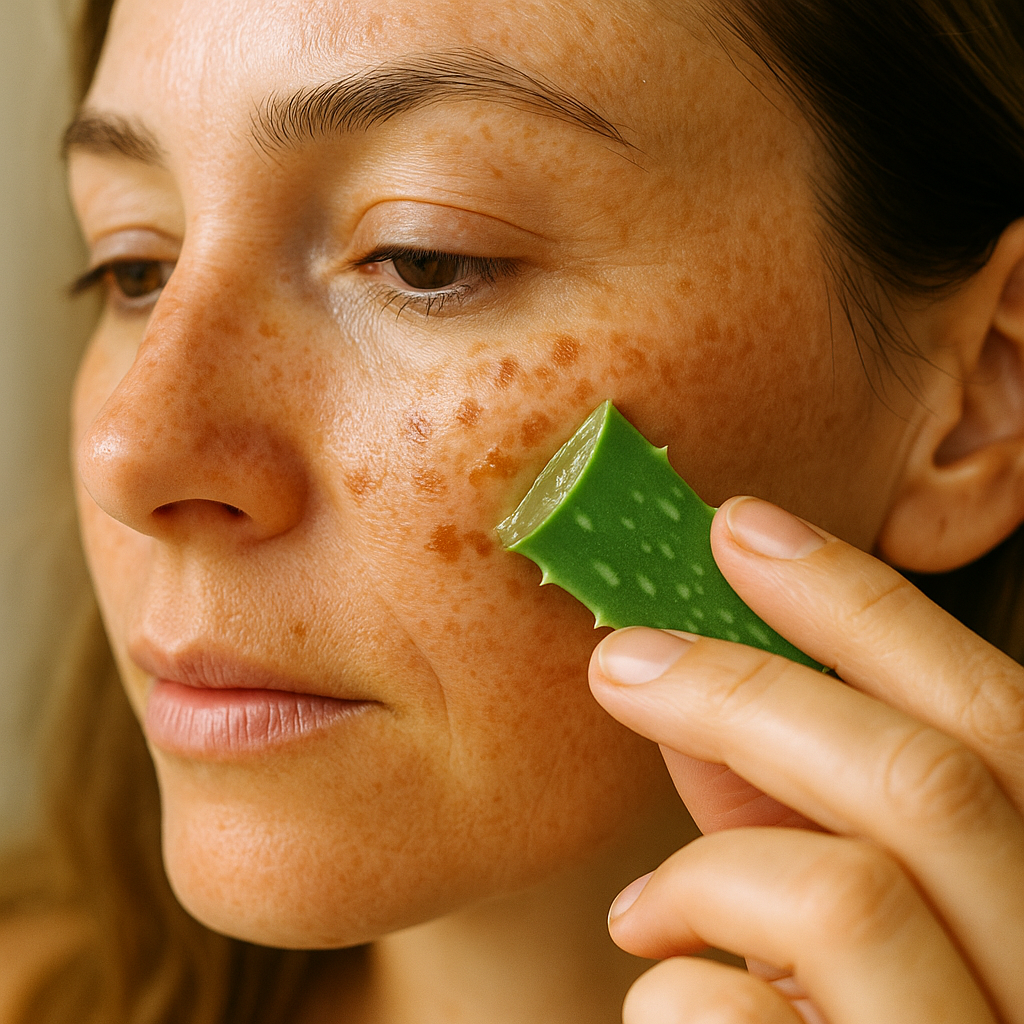
What Professional Treatments Are Available for Sun Spots?
When natural methods are not enough or you seek faster results, professional treatments offered at specialized clinics can effectively reduce or remove sun spots. These techniques often stimulate skin renewal or directly target pigmentation.
Simcoe Cosmetic Clinic, a trusted medspa, offers tailored options for individuals desiring youthful skin without surgery.
Chemical Peels
Chemical peels use acids like glycolic, lactic or trichloroacetic acid to exfoliate the skin’s surface. This promotes regeneration of new, evenly pigmented skin cells. Chemical peels vary in strength and recovery time depending on the formula used and skin condition.
Laser Skin Resurfacing
Laser treatments target melanin-containing cells or the superficial skin layers, breaking down sun spots and encouraging fresh skin growth. Laser options include IPL (Intense Pulsed Light) and fractional lasers, customized by skin tone and spot depth.
Microneedling
Microneedling uses tiny needles to create micro-injuries, stimulating collagen production and encouraging skin repair. Combined with topical serums, it can improve pigmentation and texture effectively.
Topical Retinoids
Prescription-strength retinoids accelerate cell turnover, fade pigmentation, and help maintain clearer skin after treatment. They are often used alongside other therapies for enhanced results.
Dermabrasion
This mechanical exfoliation method removes outer skin layers, helping fade discoloration and sun spots. It requires a skilled professional and some downtime for skin healing.
Each treatment plan is personalized at medspas based on your skin type, spot severity, and lifestyle. Discuss your options with certified dermatologists or cosmetic professionals for the safest and most effective approach.
Are you curious which treatment might fit best for your skin? Scheduling a skin consultation can get you the expert opinion you need to make informed decisions.
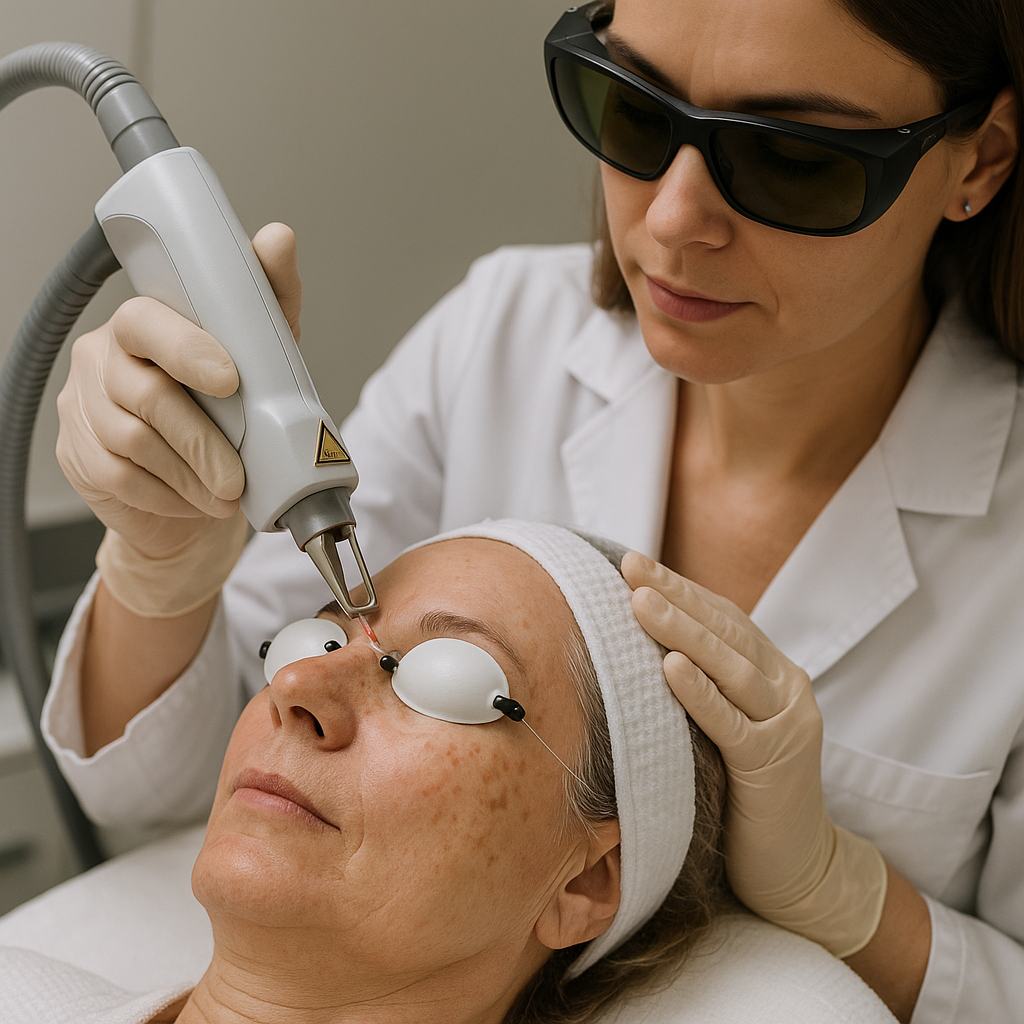
How to Build a Skincare Routine for Maintaining an Even Skin Tone?
Once you take steps to reduce sun spots, maintaining an even, healthy skin tone requires consistent care and protection.
Here’s a step-by-step skincare routine for daily maintenance and prevention:
- Gentle Cleansing: Use a mild cleanser suited to your skin type twice daily to remove impurities without stripping moisture.
- Exfoliation: Incorporate gentle exfoliants 1-2 times weekly to promote cell turnover but avoid over-exfoliating, which can worsen pigmentation.
- Targeted Treatment: Apply serums with antioxidant ingredients like vitamin C, niacinamide, or glycolic acid to fade spots and protect skin.
- Moisturizing: Hydrate your skin daily with non-comedogenic moisturizers to maintain skin barrier function.
- Sun Protection: Finish every routine with a broad-spectrum sunscreen of at least SPF 30. Reapply throughout the day, especially if outdoors.
- Healthy Lifestyle: Stay hydrated, eat antioxidant-rich foods, and avoid smoking to support skin health from within.
Remember, the key to preventing new sun spots and preserving a youthful glow is ongoing vigilance along with proper skincare products and treatments.
What Are the Main Differences Between Sun Spots and Other Skin Spots?
People often confuse sun spots with freckles or more serious conditions like actinic keratoses (precancerous lesions). Understanding these differences helps in choosing the right response:
| Spot Type | Appearance | Texture | Risk Level | Common Locations |
|---|---|---|---|---|
| Sun Spots (Solar Lentigines) | Flat, tan to brown, oval-shaped, smooth surface | Smooth and flat | Generally harmless but indicates sun damage | Face, hands, arms, shoulders |
| Freckles | Small, flat, brownish, often increase with sun exposure and fade without it | Smooth and flat | Benign | Face, arms |
| Actinic Keratoses (Sun Spots with Cancer Risk) | Varied colors, often rough or scaly | Rough, scaly, may be raised | Premalignant; can develop into skin cancer | Sun-exposed areas |
| Age Spots | Dark spots, similar to sun spots, often larger and clustered | Smooth | Harmless but cosmetic concern | Face, hands, back of the hands |
If any spot changes in appearance, becomes painful, or develops a rough texture, prompt dermatologist evaluation is vital.
Which Keywords Should You Use to Find Local Skin Treatments for Sun Spots?
Searching for professional help near you? Using specific local SEO keywords ensures you find the best medspa and dermatology services. For example:
- Botox Barrie
- Lip filler near me
- HIFU Barrie
- Chemical Peel Barrie
- Microneedling Barrie
- Laser treatments for sun spots near me
- PRP therapy Barrie
Including your city and service in search queries helps you discover trusted providers like Simcoe Cosmetic Clinic, who specialize in non-surgical skin rejuvenation and pigmentation solutions.
Feeling overwhelmed by treatment options? Break down your decisions by prioritizing what fits your lifestyle, skin type, and long-term goals. Expert guidance is invaluable here.
Common Myths About Treating Sun Spots Debunked
Misinformation can delay effective care. Here are myths debunked:
- Myth: Sun spots will disappear on their own without treatment.
Truth: Sun spots generally do not fade naturally and often darken with continued sun exposure. - Myth: Scrubbing skin harder removes sun spots.
Truth: Excessive scrubbing can irritate skin and worsen pigmentation by triggering inflammation. - Myth: Only older adults get sun spots.
Truth: While more common with age, sun spots can appear prematurely in younger people with frequent sun exposure. - Myth: Sunscreen is only necessary on sunny days.
Truth: UV rays penetrate clouds, so daily sunscreen is essential year-round to prevent new spots.
Understanding facts helps you make informed choices and avoid ineffective or harmful practices.
How Can Diet and Lifestyle Affect Skin Pigmentation and Sun Spot Appearance?
Skin health is influenced not just by external care but also by what you eat and how you live. Here’s how diet and habits affect pigmentation:
- Antioxidant-Rich Foods: Vitamins A, C, and E found in colorful fruits and vegetables help combat free radicals from sun damage, supporting skin repair and reducing hyperpigmentation.
- Hydration: Drinking adequate water maintains skin elasticity and glow, improving the overall appearance.
- Avoid Smoking: Smoking accelerates skin aging and uneven pigmentation by reducing blood flow and increasing oxidative stress.
- Limit Alcohol: Excess alcohol can dehydrate skin and impair healing processes.
- Manage Stress: High stress levels may worsen inflammation and skin problems through hormonal imbalances.
Incorporating wellness practices alongside topical and professional treatments magnifies benefits for clearer skin.
What Are the Steps for Safely Using At-Home Remedies to Treat Sun Spots?
Safety and patience are essential with at-home treatments. Follow these guidelines:
- Patch Test: Test new products or ingredients on a small skin patch for 24 hours to check for adverse reactions.
- Start Slow: Introduce active ingredients gradually; don’t overuse to avoid irritation.
- Sun Protection: Always apply sunscreen after treatment since exfoliating agents increase sun sensitivity.
- Avoid Mixing Strong Actives: Using glycolic acid, vitamin C, and retinoids simultaneously can cause irritation; consult a professional for best combinations.
- Consistency: Use daily or as directed to build gradual improvements.
- Listen to Your Skin: If redness, peeling, or discomfort worsen, discontinue use and seek advice.
Following these steps helps maximize safety and effectiveness, avoiding common pitfalls.
How Do Professional Clinics Tailor Treatments for Sun Spots?
Reputable clinics like Simcoe Cosmetic Clinic assess your skin carefully before recommending treatments. They consider factors such as:
- Skin type and tone
- Size, color, and number of sun spots
- Presence of other skin concerns like wrinkles or scars
- Your lifestyle and preferences
- Previous treatments and skin sensitivities
Combining treatments, such as starting with a chemical peel followed by topical retinoids or laser therapy interspersed with microneedling, may deliver superior results. Providers also design maintenance plans to prevent recurrence.
Comprehensive approaches cater to your unique needs, enhancing safety and satisfaction.
How Can You Distinguish Harmless Sun Spots from Dangerous Skin Changes?
Regular skin monitoring is vital. Harmless sun spots are smooth, flat, and uniform in color. However, watch for warning signs that suggest something more serious, such as actinic keratoses or melanoma:
- Rough or scaly texture
- Color variation, especially black, red, or white patches
- Rapid size increase or shape changes
- Bleeding, itching, or pain
If you notice any such changes, contact a dermatologist promptly. Early detection of skin cancer significantly improves outcomes. When in doubt, it’s always safer to have suspicious lesions professionally evaluated.
FAQ About Getting Rid of Sun Spots on the Face
How long does it take to see results from natural remedies for sun spots?
Natural remedies may take several weeks to months of consistent use before noticeable fading occurs. Patience and daily application are essential.
Are sun spots permanent?
Sun spots are long-lasting and tend to persist without treatment, but they can be lightened or removed with appropriate care.
Can I use lemon juice directly on my face to remove sun spots?
Lemon juice is acidic and can irritate skin. It should be diluted, applied cautiously, and followed by sunscreen to prevent sensitivity.
Is laser treatment safe for all skin types?
Laser treatment safety varies by skin type and spot characteristics. A consultation with an expert ensures treatments safe for your skin tone and condition.
What lifestyle changes can help prevent sun spots?
Consistent sun protection, avoiding tanning beds, using antioxidant-rich skincare products, and healthy diet habits all help prevent new sun spots.
What’s Your Next Step?
Tell us in the comments: How will you apply this to your journey to radiant skin? For expert insights and personalized skin rejuvenation options, explore our detailed chemical peel treatments at Simcoe Cosmetic Clinic.
Remember, sun spots are not a life sentence. Whether you choose natural remedies or advanced professional treatments, consistent care and sun protection unlock your skin’s potential for a brighter, youthful complexion.
Take control of your skin’s story today!
Resources:

